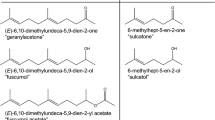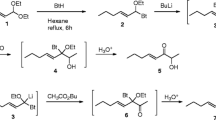Abstract
Matsunone, (2E,4E)-4.6,10,12-tetramethyl-2,4-tridecadien-7-one, is the primary sex pheromone ofMatsucoccus resinosae, M. thunbergianae, andM. matsumurae. The synthetic compound was tested in the laboratory and in field tests with all three species, and significantly more males responded to synthetic matsuone than to controls. The attraction of synthetic matsuone to males in field tests was not significantly different from that of virgin females at the same matsuone release rate. An analog of matsuone previously shown to be biologically active was also tested in the laboratory withM. resinosae andM. thunbergianae, and field tested withM. resinosae. The active analog required a dose approximately 100 times greater than matsuone to yield maximum laboratory bioassay response, and in field tests, attraction was not significantly different from controls at doses at which matsuone was significantly attractive.
Similar content being viewed by others
References
Angerilli, N.F.D., andLogan, D.M. 1986. The use of pheromone and barrier traps to monitor for San Jose scale (Homoptera: Diaspididae) phenology in the Okanagan Valley of British Columbia.Can. Entomol. 118:767–774.
Bar-Zakay, I., Peleg, B.A., andHefetz, A. 1989. Mating disruption of the California red scaleAonidiella aurantii (Homoptera: Diaspididae).Hassadeh 70:1228–1231.
Bean, J.L., andGodwin, P.A. 1955. Description and bionomics of a new red pine scale,Matsucoccus resinosae.For. Sci. 1:164–197.
Carle, P. 1968. Méthode d'obtention massive des pontes deMatsucoccus feytaudi Duc. (Coccoidea, Margarodidae) par piégeage des femelles.Ann. Sci. For. 25:57–68.
Carle, P. 1974. Le dépérissement du pin mésogéen en Provence.Ann. Sci. For. (Paris) 31:1–26.
Conover, W.J., andIman, R.L. 1981. Rank transformations as a bridge between parametric and nonparametric statistics.Am. Stat. 35:124–129.
Doane, C.C. 1966. Evidence for a sex attractant in females of the red pine scale.J. Econ. Entomol. 59:1539–1540.
Duncan, D.B. 1955. Multiple range and multipleF tests.Biometrics 11:1–42.
Ervin, R.T.,Moreno, D.D.,Baritelle, J.L., andGardener, P.D. 1985. Pheromone monitoring is cost effective.Calif. Agric., Sept.–Oct. 17–18.
Lanier, G.N., Qi, Y., West, J.R., Park, S.C., Webster, F.X., andSilverstem, R.M. 1989. Identification of the sex pheromone of threeMatsucoccus pine bast scales.J. Chem. Ecol. 15:1645–1659.
Li, G., Ahoqng, L., Han, R., Liu, X., andXia, R. 1980. A study on the pine stem coccidMatsucoccus matsumurae Kuwara.Rep. Inst. For. Lianoing Prov. 9:1–27.
McClure, M.S. 1976. Colonization and establishment of the red pine scale,Matsucoccus resinosae (Homoptera: Margarodidae) in a Connecticut plantation.Environ. Entomol. 5:943–947.
McClure, M.S. 1983a. Temperature and host availability affect the distribution of Matsucoccus matsumurae (Kuwana) (Homoptera: Margarodidae) in Asia and North America.Ann. Entomol. Soc. Am. 76:761–765.
McClure, M.S. 1983b. Population dynamics of pernicious parasite; density dependent vitality of the red pine scale.Ecology 64:710–718.
Mendel, Z., Shaphir, N., Madar, Z., Golan, Y., Schpeter, E., andZehavi, A. 1988. The effect of habitat and age of the Aleppo pine plantation on damage caused byMatsucoccus josephi.Hassadeh 68:2203–2207.
Moreno, D.S., andKennett, C.E. 1981. Monitoring insect pest populations by trapping in California citrus orchards.Proc. Int. Soc. Citriculture 2:684–689.
Moreno, D.S., andKennett, C.E. 1985. Predictive year-end California red scale (Homoptera: Diaspididae) orange fruit infestations based on catches of males in the San Joaquin Valley.J. Econ. Entomol. 78:1–9.
Ortu, S., andDelrio, G. 1982. Field trials with synthetic sexual pheromone ofPlanococcus citri (Rigso).Redia 65:341–354.
Park, S.C. 1988. Biology and pheromone-mediated behavior ofMatsucoccus thunbergianae in Korea with reference toM. resinosae in the United States ((Homoptera: Coccoidea: Margarodidae). PhD thesis. State University of New York, Syracuse, New York.
Park, S.C., West, J.R., Abrahamson, L.P., Lanier, G.N., andSilverstein, R.M. 1986. Crossattraction between two species ofMatsucoccus. Extraction, bioassay, and isolation of the sex pheromone.J. Chem. Ecol. 12:609–617.
Pfeiffer, D.G. 1985. Pheromone trapping of males and prediction of crawler emergence for San Jose scale (Homoptera: Diaspididae) in Virginia apple orchards.J. Entomol. Sci. 20:351–353.
Qi, Y., Yang, M., andZhao, F. 1983. A preliminary study of the sex pheromone of the Japanese pine bast scaleMatsucoccus matsumurae (Kuwana) (in Chinese, English summary).Contrib. Shanghai Inst. Entomol. 3:21–28.
Rotundo, G., Tremblay, E., andGlacometii, R. 1979. Final results of mass captures of the citrophilous mealybug males (Pseudococcus calceolariae Mask.) (Homoptera: Pseudococcidae) in a citrus grove.Bull. Lab. Entomol. Agric. Portici 30:266–274.
SAS Institute. 1985. SAS User's Guide: Statistics.SAS Institute, Cary, North Carolina.
Sternlicht, M., Bar-Zakay, I., Szivos, Y., andDunkelblum, E. 1981. Prediction of infestation by and control of the California red scale,Aonidiella aurantii (Maskell), through use of its pheromone.Proc. Int. Soc. Citriculture 2:695–700.
Sternlicht, M., Dunkelblum, E., andGieselmann, M.J. 1983. Management of scale insects through utilization of their pheromone. Bet Dagan, Israel (unpublished).
Webster, F.X.,Zhang, A.,Park, S.K., andPrestwich, G.D. 1990. Synthesis of matsuone, the sex pheromone of the red pine scale.J. Org. Chem. In press.
Winer, B.M. 1971. Statistical Principles in Experimental Design, 2nd ed. McGraw-Hill, New York.
Young, B., andQi, Y. 1983. Application of sex pheromone to the identification of pine bast scales (Margarodidae, Coccoidea).Contrib. Shanghai Inst. Entomol. 3:273–278. (Chinese, English summary).
Young, B., Miller, D.R., andMcClure, M.S. 1984. Attractivity of th female sex pheromone of ChineseMatsucoccus matsumurae (Kuwana) to males ofM. matsumurae in Japan and to males ofM. resinosae Bean and Godwin in the United States (Margarodidae, Coccoidea, Homoptera).Contrib. Shanghae Inst. Entomol. 4:1–20.
Author information
Authors and Affiliations
Additional information
Homoptera: Coccoidea: Margarodidae.
Deceased.
Rights and permissions
About this article
Cite this article
Hibbard, B.E., Lanier, G.N., Parks, S.C. et al. Laboratory and field tests with the synthetic sex pheromone of threeMatsucoccus 1 pine bast scales. Journal of Chemical Ecology 17, 89–102 (1991). https://doi.org/10.1007/BF00994424
Received:
Accepted:
Issue Date:
DOI: https://doi.org/10.1007/BF00994424




